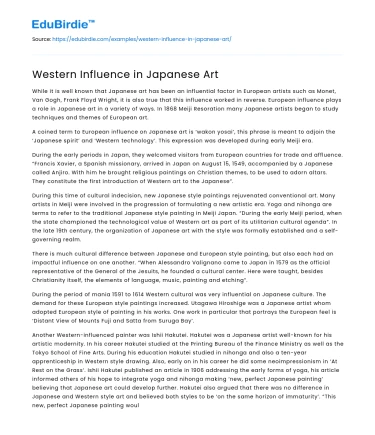While it is well known that Japanese art has been an influential factor in European artists such as Monet, Van Gogh, Frank Floyd Wright, it is also true that this influence worked in reverse. European influence plays a role in Japanese art in a variety of ways. In 1868 Meiji Resoration many Japanese artists began to study techniques and themes of European art.
A coined term to European influence on Japanese art is ‘wakon yosai’, this phrase is meant to adjoin the ‘Japanese spirit’ and ‘Western technology’. This expression was developed during early Meiji era.
Save your time!
We can take care of your essay
- Proper editing and formatting
- Free revision, title page, and bibliography
- Flexible prices and money-back guarantee
During the early periods in Japan, they welcomed visitors from European countries for trade and affluence. “Francis Xavier, a Spanish missionary, arrived in Japan on August 15, 1549, accompanied by a Japanese called Anjiro. With him he brought religious paintings on Christian themes, to be used to adorn altars. They constitute the first introduction of Western art to the Japanese”.
During this time of cultural indecision, new Japanese style paintings rejuvenated conventional art. Many artists in Meiji were involved in the progression of formulating a new artistic era. Yoga and nihonga are terms to refer to the traditional Japanese style painting in Meiji Japan. “During the early Meiji period, when the state championed the technological value of Western art as part of its utilitarian cultural agenda”. In the late 19th century, the organization of Japanese art with the style was formally established and a self-governing realm.
There is much cultural difference between Japanese and European style painting, but also each had an impactful influence on one another. “When Alessandro Valignano came to Japan in 1579 as the official representative of the General of the Jesuits, he founded a cultural center. Here were taught, besides Christianity itself, the elements of language, music, painting and etching”.
During the period of mania 1591 to 1614 Western cultural was very influential on Japanese culture. The demand for these European style paintings increased. Utagawa Hiroshige was a Japanese artist whom adopted European style of painting in his works. One work in particular that portrays the European feel is ‘Distant View of Mounts Fuji and Satta from Suruga Bay’.
Another Western-influenced painter was Ishii Hakutei. Hakutei was a Japanese artist well-known for his artistic modernity. In his career Hakutei studied at the Printing Bureau of the Finance Ministry as well as the Tokyo School of Fine Arts. During his education Hakutei studied in nihonga and also a ten-year apprenticeship in Western style drawing. Also, early on in his career he did some neoimpressionism in ‘At Rest on the Grass’. Ishii Hakutei published an article in 1906 addressing the early forms of yoga, his article informed others of his hope to integrate yoga and nihonga making ‘new, perfect Japanese painting’ believing that Japanese art could develop further. Hakutei also argued that there was no difference in Japanese and Western style art and believed both styles to be ‘on the same horizon of immaturity’. “This new, perfect Japanese painting would have diverse styles and concepts, with European and Western characteristics mixed in various portions the paintings might have some things in common, but they would branch out and reach the realm of truth and beauty each on their own”. Hakutei also alleged that all artists should be able to represent a ‘Western style form’ as well as ‘Japanese style lines’ to make harmony in a painting.
The famous painting titled ‘Morning Toilette’ by Kuroda Seiki associated with a monumental time era when Japanese art seemed to collide with sets of social norms and culture. This was the first nude painting to be publicly exhibited in Japan. “The Morning Toilette controversy amplified the ongoing debate over the proper place of Western painting (yoga) – essentially, European oil painting – in Japan in a complex time of modernization and cultural revitalization”. This painting done in 1893 shows historical significance to the cross-cultural representation of European and Japanese art.
The acceptance of European influence was not always seen as a positive influence to many of the Japanese. The Japanese would view the European travels as suspicious, and they were wary to their motive at times. In the 1630’s the Sakoku Edicts were issued which restricted all foreigners access to Japan, the only exception was the Dutch. In an article by Stevenson (1901), explores a piece of ‘Japanese ivory carvings’, and their Dutch influence. “During this period, European ornament and influence was introduced in Japanese art”. There are five ancient carvings known as ‘netsukes’, each of these carvings depict a Dutchman. The Dutchman are nearly always shown holding birds, it is said that this is to be symbolic. “It is therefore not impossible that some symbolic meaning may attach to the birds here represented; although it is stated that cock fighting was practiced from early times in Japan”.
In conclusion, while it is well documented that Japanese art has been an influential factor in European artists, there was also a European influence on Japanese artists in the Meiji Era. There are many different styles and techniques used in Japanese art that has been linked to Western culture. In addition, there are many Japanese artists that practiced the European style and techniques of painting and drawing. There is even term for the European influence on Japanese art is ‘wakon yosai’, this phrase is meant to adjoin the ‘Japanese spirit’ and ‘Western technology’.






 Stuck on your essay?
Stuck on your essay?

